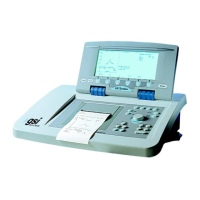Troubleshooting
Mic
. MUX
The Microphone Multiplexer is a CMOS analog switch located on the Analog Sche-
matic. This multiplexer circuit’s main function, during normal mode operation, is to
route the filtered probe microphone signal to the Signal ProcessorA/D converter
(digital board Schematic). There are three additional signals connected to it, which
during initialization, are monitored as integrity checks to provide diagnostic informa-
tion. These additional signals are as follows:
1) Probe Speaker Level 1 (Analog Schematic)
2) Probe Speaker Level 2 (Analog Schematic)
3) Microphone Circuit Ground (Analog Schematic)
NOTE
Routing the probe speaker drive levels with this multiplexer enables you to
completely bypass the probe assembly when checking Y/B/G measurement
circuitry integrity.
The various signals can be routed to the signal processorA/D by selecting the MUX
INPUTS softkey, then the MIC MUX softkey.
Probe tone and filter The various probe tone frequencies can be selected and turned ON or OFF by
mode selecting the PROBE/FILTER softkey. When this softkey is selected, additional
softkeys are displayed that allow you to select the microphone filter type, the probe
tone frequency and the probe tone signal for ON or OFF. These selections enable
you to troubleshoot the probe tone oscillator, probe tone channel, probe assembly
and microphone filter circuitry.
DAC levels The level control DACs (Digital to Analog Converters) can be selected and pro-
grammed in this mode (Refer to the Level Control Schematic or Level Control/Stim
Schematic). The DACs can be accessed by pressing the DAC LEVEL softkey,
then the desired DAC. When the desired DAC is selected, you can increment or
decrement the DAC output by one or ten bits at a time. The DACs control VCAs
(Voltage ControlledAmplifiers) on theAnalog board. When the DACs are set to 0,
the VCAs are at full gain. With the DACs set to 255 the VCAs are at minimum gain
(full attenuation).
Routing The Ipsi and Contra channel signals can be routed to either the Ipsi or Contra
transducer in this mode. This mode controls the Ipsi and Contra Mixer circuits
(Analog Switches) shown on the Analog Schematic. Access to this mode is gained
by selecting the ROUTING softkey. When Routing is selected, four additional
softkeys will be displayed:
I-I:
Routes the Ipsi channel to the Ipsi transducer
I-C: Routes the Ipsi channel to the Contra transducer
C-I: Routes the Contra channel to the Ipsi transducer
C-C: Routes the Contra channel to the Contra transducer
GSI TympStar Version 1 and Version 2 Service Manual 8 - 25

